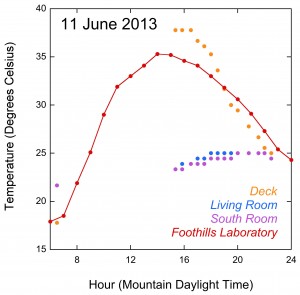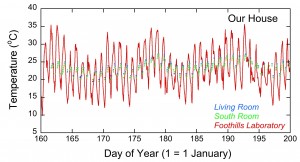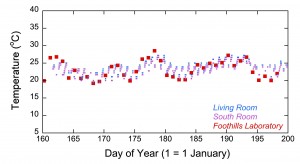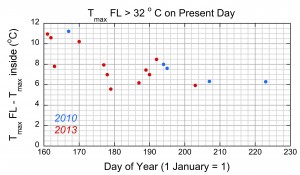This week we again welcome long-time friend of GLOBE, Dr. Peggy LeMone, Chief Scientist for the GLOBE Program from 2003-2009, as our guest blogger. Dr. LeMone is currently working in the field of weather and cloud formation at the National Center for Atmospheric Research (NCAR).
Dr. Peggy LeMone,
Credit: UCAR
Today, many homes and public areas have air conditioners to keep families cool during the hot months of the year. This was not true 50 years ago, when a visit to the movie theater (which was air-conditioned) or a swim in a nearby lake, ocean, or swimming pool would ease the heat. Hospitals in the town where I grew up would cool their operating rooms by bringing in big pieces of ice.
Though many homes in Colorado have air-conditioning, the climate is sufficiently mild that a large percentage of families, including mine, do not have air conditioning. I’d like to share a strategy my family has adopted to keep us comfortable most of the time.
Being scientists, my husband and I open and shut the doors, windows, and window shades of our house according to the temperature inside and outside of the house. Figure 1 displays the air temperature of a typical day.
Figure 1. Temperatures around our house, and at NCAR’s Foothills Lab, about 3.3 kilometers to the east. To convert afternoon times to p.m., simply subtract 12.
We use the digital thermometers on our two furnaces for the temperature inside the living room and the room to the south. The outside thermometer, on our deck, has not been properly shielded since we had to remove a tree. Thus we include a nearby temperature measurement, from the National Center for Atmospheric Research (NCAR) Foothills Lab, for comparisons.
During the day, we typically keep the house closed up – this means all windows and doors closed and many shades down — until the air outside is cooler than the air in the house. As you can see from the graph, this happens around 22:00 (or 10:00 p.m.) Mountain Daylight Time (MDT), so direct sunlight on the deck thermometer is no longer a problem. Once the indoor and outdoor temperatures are equal, we open up the windows, and use fans to bring in the cool, outside air. The following morning, if we are at home, we again close up windows and doors when the outside temperature increases to the same as the inside temperature. During the week, we close up the house when we leave. The net effect of this strategy is to keep the house cool during the day – more than 10 degrees cooler at the time of maximum outside temperature!
You might notice that the air temperature inside the house keeps increasing, long past the time of the maximum outside temperature. This may seem odd at first, but it makes sense: as long as the air outside the house is warmer than the air inside, the house will continue to be warmed. Of course if we left the windows open all day, the high temperature inside the house would occur closer in time to the outside maximum temperature (and of course the temperatures would be closer as well).
How does this work from day to day? Figure 2 compares the outside temperatures at Foothills Lab to our indoor temperatures between 9 June and 7 July. The inside temperatures vary less during the day than those outside (as seen in Figure 1). They also vary less from day to day. The largest differences between inside and outside maximum temperatures are on the hottest days.
Figure 2. Inside and outside temperatures from 9 June (Day 160) through 19 July (Day 200).
Notice that the inside minimum temperatures remain warmer than those outside, in spite of our trying to draw in outside air. The house temperatures also vary less than the daily average temperatures, as seen in Figure 3.
Figure 3. For the same period of time, but with daily average Foothills Lab temperature.
If you look carefully at Figure 2, you can see that the opening and closing strategy doesn’t work as well in late summer, with inside temperatures closer to outside temperatures. This effect becomes even more obvious in Figure 4, which shows the difference between the inside and outside temperature maxima for the hottest days. (Note that data weren’t collected every day in 2010, so there could have been more warm days.)
Figure 4. Difference between living-room max temperature and that at Foothills when outside temperature exceeds 32o Celsius.
How is the indoor air temperature regulated at your home or school? Let us know by adding a comment!






Well researched Dr.
I will try the same and post the results.
Hi Dr. Peggy it is very nice to see your article.Nowdays people can’t survive summer naturally means they can’t live without air conditioner in the summer but before 50-60 years its totally different.People used lake or oceans to bath and to cool their body in the summer.I also like your other points regarding this.Keep updating more posts.Glad to see this article
I remember the days when we would just wet a cloth and lie next an oscillating fan. But you the tell the kids today and they wouldn’t believe you!
We have air conditioner to keep cool during the summer in Turkey.
Your article is great, thank you.
Thanks a very good account of your work you expect Displaced
Excellent topic with details, easy to understand. Please keep up the good work.
a great post as always
thank you and have a great continuation
That’s a nice research Dr. Peggy, my indoor temperatures are regulated air-conditioner.
This also applies to my country, it is spring – summer and the air conditioning temperature the people usually regulate only by the sense of body temperature.
People not regulate by a technical issue, because they rather by how feel it.
Best regards from Chile.
Doctor Santiago Chia E.
This information is great!
Very useful information.
Thanks for sharing Dr. Peggy. Highly Appreciated. Great Advice indeed.
thank you and have a great continuation
very good article
in my country people try to eat hot food in hot weather to stand hot weather…
thanks for sharing
We’re from Melbourne and this sort of information is relevant to us, too, especially if you live in some of the more rural areas (where temperatures can easily soar into the high 30 or even 40 degree Celsius range). Even in our office, we often find that the temperature inside at the end of the day is much hotter than outside – we have floor to ceiling windows along one side of our suite and this really heats up the air inside!
Thanks for the great research!
Well planned informative article. Thank you Dr.Peggy.
Great Tips
thanks for sharing.
Hi Peggy, thanks for sharing your article. I found it very informative.
Great findings. I remember some of the old water air vent systems, had a water container where I used to put some ice in and that would bring the temperature down significantly as water was being circulated in the system.
Earth heats up, we should listen to the advice of the experts, thank you.
waiting for the next article.
Wow ! the weather in my country is cool now. Thanks for the good information !
That’s great information , thank you
Thank you for everything on this information is great.